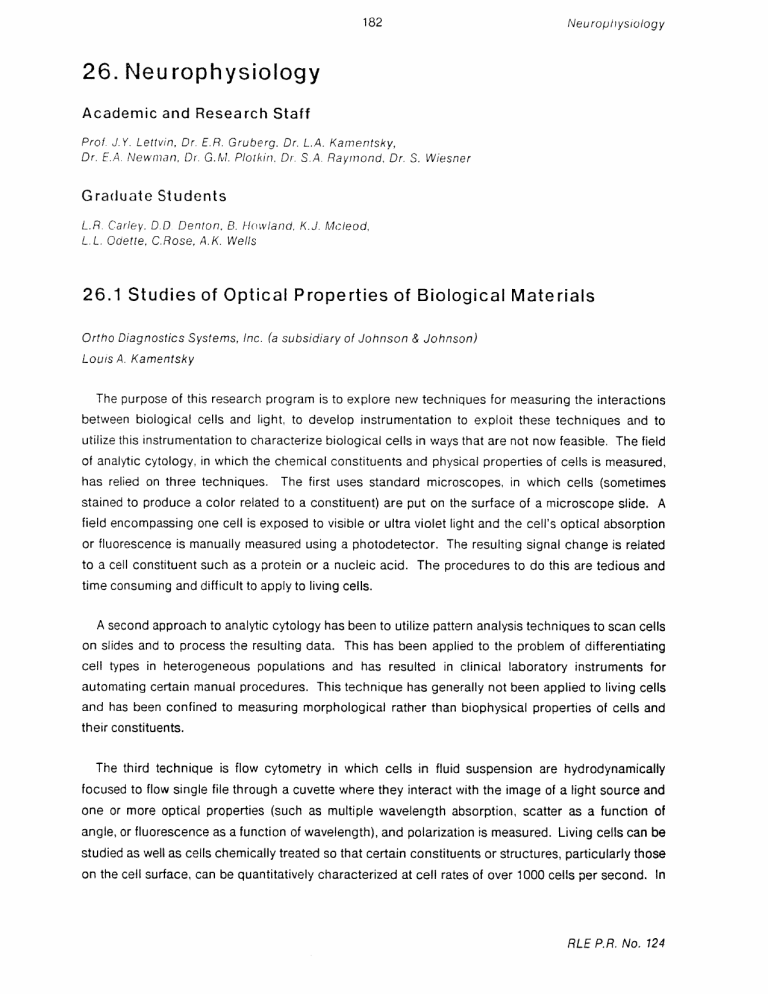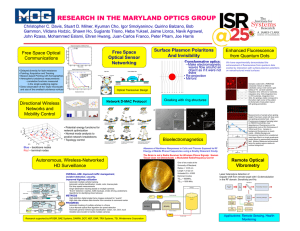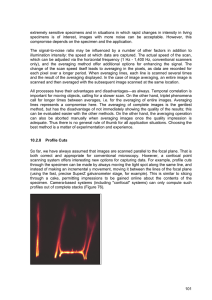26. Neurophysiology Academic and Research Staff

182
26. Neurophysiology
Academic and Research Staff
Prof. J.Y. Lettvin, Dr. E.R. Gruberg. Dr. L.A. Kamentsky,
Dr. E.A. Newman, Dr. G.M. PlotAin, Dr. S.A. Raymond, Dr. S. Wiesner
Graduate Students
L.R. Carley. D.D Denton, B. I-owvland, K.J. Mcleod,
L.L. Odette, C.Rose, A.K. Wells
Neu rophysiology
26.1 Studies of Optical Properties of Biological Materials
Ortho Diagnostics Systems, Inc. (a subsidiary of Johnson & Johnson)
Louis A. Kamentsky
The purpose of this research program is to explore new techniques for measuring the interactions between biological cells and light, to develop instrumentation to exploit these techniques and to utilize this instrumentation to characterize biological cells in ways that are not now feasible. The field of analytic cytology, in which the chemical constituents and physical properties of cells is measured, has relied on three techniques. The first uses standard microscopes, in which cells (sometimes stained to produce a color related to a constituent) are put on the surface of a microscope slide. A field encompassing one cell is exposed to visible or ultra violet light and the cell's optical absorption or fluorescence is manually measured using a photodetector. The resulting signal change is related to a cell constituent such as a protein or a nucleic acid. The procedures to do this are tedious and time consuming and difficult to apply to living cells.
A second approach to analytic cytology has been to utilize pattern analysis techniques to scan cells on slides and to process the resulting data. This has been applied to the problem of differentiating cell types in heterogeneous populations and has resulted in clinical laboratory instruments for automating certain manual procedures. This technique has generally not been applied to living cells and has been confined to measuring morphological rather than biophysical properties of cells and their constituents.
The third technique is flow cytometry in which cells in fluid suspension are hydrodynamically focused to flow single file through a cuvette where they interact with the image of a light source and one or more optical properties (such as multiple wavelength absorption, scatter as a function of angle, or fluorescence as a function of wavelength), and polarization is measured. Living cells can be studied as well as cells chemically treated so that certain constituents or structures, particularly those on the cell surface, can be quantitatively characterized at cell rates of over 1000 cells per second. In
RLE P.R. No. 124
183 Neurophysiology this way large popuilations of cells can be studied. This, in turn, allows the biologist to gain statistically significant information about numerically small sub-populations of cells. This technique is widely used in clinical laboratory instruments and in biomedical research. However, it, or any other technique, cannot now practically measure the kinetic properties of live cells in large heterogeneous populations. nor can it be used to study the flow of biological information in and between living cells such as neurons or blood cells. This is because the identity of each cell measured is not maintained, or the measurements take too long. Additionally, flow cytometry cannot be used with certain newer laser spectroscopic techniques that could provide useful information about the number and physical properties of molecules on the cell surface.
This research program attempts to initially develop methods extending some of the concepts of flow cytometry in which, rather than move cells through a cuvette, the cells are immobilized. The image of a laser light source is programmed first to find each cell within large populations of cells, then to repeatedly measure one or optical properties of each cell under the control of a computer.
The cells can be made to interact with various agents or with each other during the measurements.
The first instrumented system is now at an early stage of fabrication. It will consist of an optical table on which the beams of both an helium neon laser, used for finding cells and measuring their scatter properties, and an argon ion laser, used for exciting the fluorescence of dyes bound to cells, are images through a computer-controlled shutter to an inverted microscope. The stage of this microscope can be moved two-dimensionally in one-micron increments by computer-controlled stepping motors. The cells are immobilized in a gel on the surface of a plate attached to the stage.
The field image is detected by a set of photomultipliers so as to measure various optical properties of the field, and their signals are sent to be digitized and processed by the computer. (Data General
MPT-100 with sensor I/O). The first computer programs to be written will establish the best strategy for rapidly finding the position of each of about 1000 cells, and to control the stage to repeatedly measure fluorescence-based interactions of the cells after they have been reacted with various reagents. One initial study will measure fluorescence of cells accumulating a fluorescent dye whose incorporation into the cell is related to the cell's transmembrane potential. In this case, cells within a population are activated by various cell surface ligands to cause transmembrane potential changes.
A second initial study will attempt to increase the sensitivity of detection of specific cell surface determinants in large heterogeneous populations using fluorescently tagged antibodies to these molecules. The instrument will be programmed to measure the fluorescence of each cell in turn for a length of time sufficient to obtain an appropriate signal-to-noise ratio to detect the determinant.
A third initial study will attempt to study the transmission of action potential within and among cells such as neurons, using transmembrane potential sensitive dyes.
This research program should lead to other directions for development of new methodology. We
RLE P.R. No. 124
184 Neurophysiology have described the use of cell constituent-specific dyes. transport modulatable dyes and antibody markers to cell surface molecules. We would plan to study additional optical interactions of cells, such as dye-to-dye energy transfer, to measure the distance between structures, electric fieldsensitive fluorescent dyes to study potential gradients in cells, and fluorescence anisotropy and life-time measurement to study the structure, orientation or motion of cell structures. A second direction for the research should be towards increasing spatial resolution of our measurements to confine the measured volume to parts of cells such as cell surface membranes. The position and focal plan of the measured interaction will be more precisely positioned and oscillated under control of a computer viewing these interactions. We believe that this program of exploiting optical interactions with cell structures may provide a great variety of useful information for the biologist to understand structure and function in single cells, or networks of cells.
RLE P.R. No. 124






